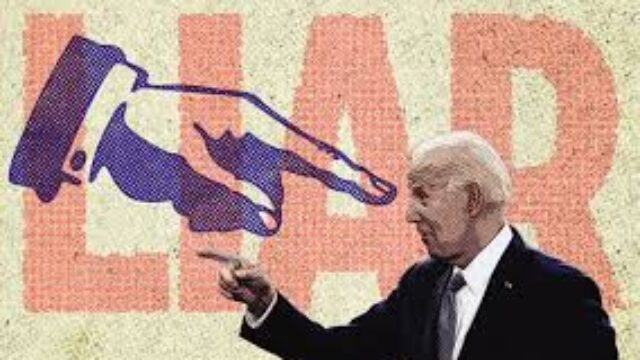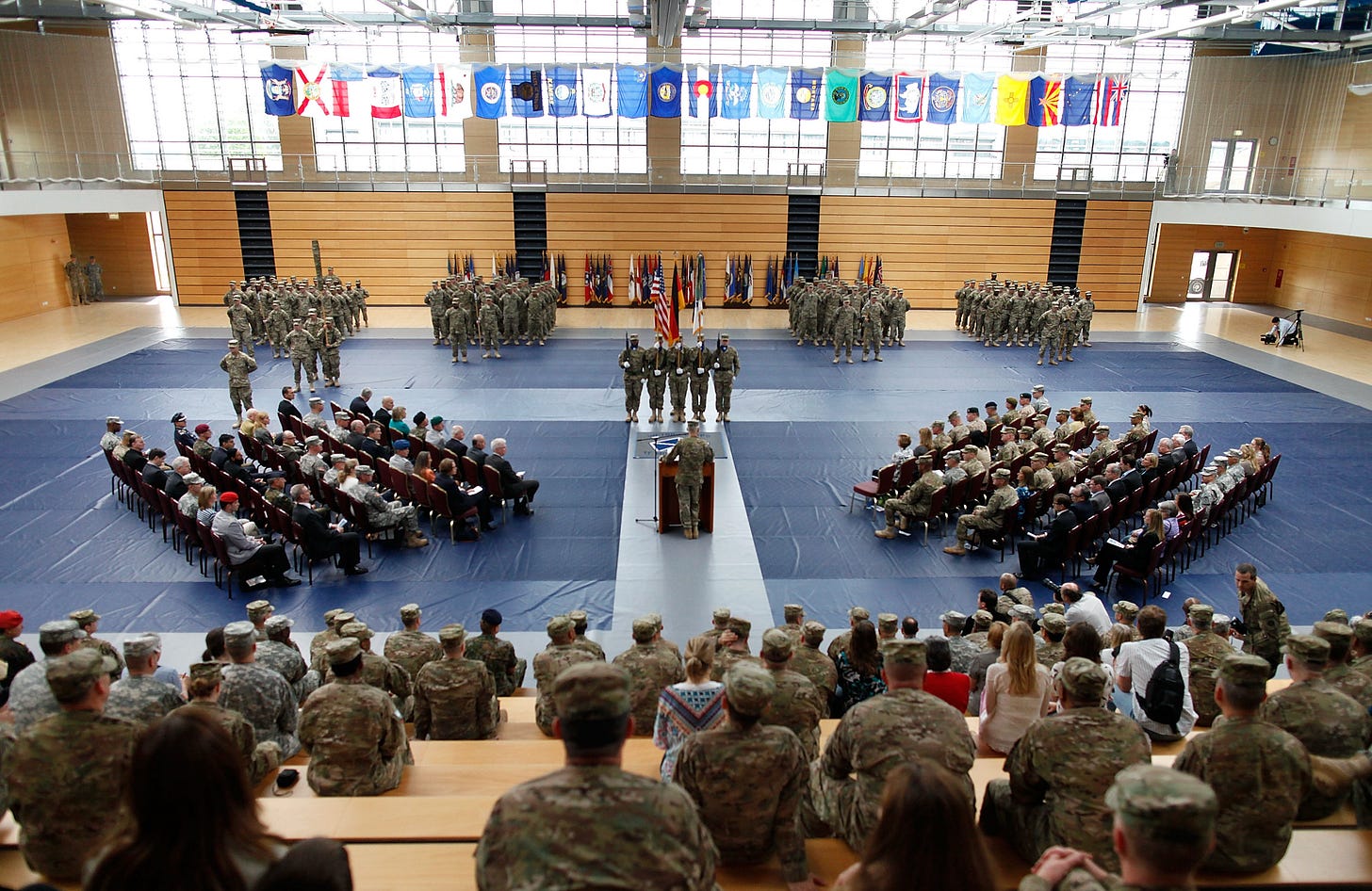Biden Lied About Everything, Including Nuclear Risk, During Ukraine Operation

From “The Secret History of the War in Ukraine” in the New York Times:
At a hastily arranged meeting on the Polish border, General Zaluzhny admitted to Generals Cavoli and Aguto that the Ukrainians had in fact decided to mount assaults in three directions at once.
“That’s not the plan!” General Cavoli cried…
Fifteen months into the war, it had all come to this tipping point.
“We should have walked away,” said a senior American official.
But they would not.
When Ukrainian President Volodymyr Zelensky visited the White House nearly a month ago, the New York Times packed its pages with stories denouncing Donald Trump and J.D. Vance for abandoning Ukraine, and the impolitic “dressing down” of a friendly foreign leader. The Times like most Western news outlets for years suggested that anything short of a full-throated expression of support for war was a betrayal of the “democratic world order” that would lead to instant battlefield deaths.
Now that the war appears lost, and newspapers abroad (conspicuously, not here) are full of news about an apparent bombing of Vladimir Putin’s motorcade, and the future of NATO hangs by a thread, the Times has run a 13,000-word “Secret History” that shows the same U.S. officials who denounced Trump and American voters for saying it out loud long ago concluded that they, too, should probably “walk away.”
The piece is also an extraordinarily comprehensive betrayal of Zelensky and Ukraine, exponentially worse than the “dressing down” by Trump. Authored by longtime veteran of controversial intel pieces Adam Entous, it’s sourced to 300 American and European officials who seem to be responding to their apparent sidelining via a shameless tantrum, exhibiting behavior that in the field would get military men shot. Not only do they play kiss and tell with a trove of operational secrets, they use the Times to deflect blame from their own failures onto erstwhile Slavic partners, cast as ignorant savages who snatched defeat from the jaws of America-designed victory. It’s as morally abhorrent a piece of ass-covering ever as I’ve seen in print, and that somehow is not its worst quality.
The people who quarterbacked the NATO side of the Ukraine war are so pleased with themselves, they can’t keep from boasting about things that will make the average American want to pitchfork the lot of them. Entous describes a tale told “through a secret keyhole” that reveals how America was “woven into the war far more intimately and broadly than previously understood.” (Translation: it was hidden from us.) Sources not only make it clear that the public was lied to on a continuous basis from the outset of the conflict, but they describe how we were lied to, apparently thinking the methods clever. Some are small semantic gambits the idiots wrongly believe exculpated their actions, but the main revelation involves one gigantic, inexcusable deception. From Joe Biden down, they all lied about the risk of World War III.
They risked our lives and our children’s lives, knowingly, repeatedly, and for the worst possible reason: politics. Afraid to admit a mistake, they planned individual excuses while letting bureaucratic inertia expand the conflict. Worse, as was guessed at on this site late last year, the Biden administration after last November’s election increased the risk of global conflict by “expanding the ops box to allow ATACMS and British Storm Shadow strikes into Russia,” in order to “shore up his Ukraine project.” If you check this “secret history” against contemporaneous statements of American and European leaders, you’ll find the scale of the lies beyond comprehension. Heads need to roll for this:Subscribed
The Entous feature begins as all war histories sourced to military and intelligence officials do, as a tale of triumph and ingenuity. Two months after Vladimir Putin’s invasion of Ukraine in late February 2022, two Ukrainian generals were picked up on the streets of Kyiv and driven across the Polish border by British commandos in plainclothes, after which they flew in a C-130 to “Clay Kaserne, the headquarters of U.S. Army Europe and Africa in Wiesbaden, Germany.”
Lt. Gen. Mykhaylo Zabrodskyi recalled being led “up a flight of stairs to a walkway overlooking the cavernous main hall of the garrison’s Tony Bass Auditorium,” where he looked down on a “warren of makeshift cubicles, organizing the first Western shipments to Ukraine of M777 artillery batteries and 155-millimeter shells.” The area that became a “full-fledged headquarters” had been a “gym” used for Army band performances and “Cub Scout pinewood derbies.”

Entous is literally leading us down a rabbit-hole. The “warren” of cubicles to which he referred became the war’s command center:
Side by side in Wiesbaden’s mission command center, American and Ukrainian officers planned Kyiv’s counteroffensives. A vast American intelligence-collection effort both guided big-picture battle strategy and funneled precise targeting information down to Ukrainian soldiers in the field.
One European intelligence chief recalled being taken aback to learn how deeply enmeshed his N.A.T.O. counterparts had become in Ukrainian operations. “They are part of the kill chain now,” he said.
The Wiesbaden cubicle-dwellers relayed battlefield intel to Ukrainians, where “again and again… Americans found it, and the Ukrainians destroyed it.” A mid-2022 rocket barrage in Kherson that killed “generals and staff officers,” along with a “predawn swarm of maritime drones, with support from the Central Intelligence Agency” that attacked the Russian port at Sevastopol, were together an early “proof of concept” that boosted confidence.
However, the “arc of the war shifted” when Ukrainians began calling their own plays:
The Ukrainians sometimes saw the Americans as overbearing and controlling — the prototypical patronizing Americans. The Americans sometimes couldn’t understand why the Ukrainians didn’t simply accept good advice… Where the Americans focused on measured, achievable objectives, they saw the Ukrainians as constantly grasping for the big win, the bright, shining prize.
The Ukrainians, we learned, “increasingly kept their intentions secret,” and were “angered” by America’s reluctance to “give them all of the weapons and other equipment they wanted,” while refusing to take “politically risky steps” to help them. The Times sources then blamed the “fractious internal politics of Ukraine” for causing the first major disaster, the early 2023 attempt to recapture the city of Bakhmut. The Times in May of that year called Bakhmut an “apparent loss” of a city that assumed “outsize importance” and “would have more symbolic than strategic value for Russia,” analysts said. Sunday, Entous was free to call Bakhmout a “stillborn failure.” After this sudden bout of frankness, Entous in a flashback indulged in another.
The partnership operated in the shadow of deepest geopolitical fear — that Mr. Putin might see it as breaching a red line of military engagement and make good on his often-brandished nuclear threats.
The it in that passage was the partnership. Our own officials worried that the mere act of creating the “we see it, Ukraine smashes it” collaboration, which sources boasted quickly became a “killing machine,” might be viewed as a “red line” by Putin, who in turn might “make good” on his nuclear threats.
If you’re wondering when we ever heard an American official acknowledge a non-zero threat of nuclear retaliation throughout this conflict, the answer is, never. In fact we were consistently told by Biden and everyone else that the opposite was true, that “World War III won’t be fought in Ukraine,” because the United States was not bringing its own troops into the theater of battle.
According to the Times, as Biden was saying these things, his administration “time and again… authorized clandestine operations it had previously prohibited.” This in turn forced us to “dispatch” advisers “to Kyiv and later… closer to the fighting,” out of concern of more line-crossing. The military and the CIA were then given permission to launch strikes “deep inside Russia itself,” which prompted thoughts from Entous:
In some ways, Ukraine was, on a wider canvas, a rematch in a long history of U.S.-Russia proxy wars — Vietnam in the 1960s, Afghanistan in the 1980s, Syria three decades later… It was also a grand experiment in war fighting, one that would not only help the Ukrainians but reward the Americans with lessons for any future war.
How many times were we scolded that this was no “proxy war,” and not a quagmire like Vietnam or Afghanistan? A hundred? A thousand? As early as April 28, 2022, right when this “partnership” run out of the Wiesbaden “warren” began, Biden explicitly denied we were in a proxy war, and said Russia was only making such claims to excuse their failures in defeating Ukraine.
Internally, concern along these exact lines was growing. American M777 howitzer batteries were effective at first against Russian troops, but soon they learned to pull material behind the 15-mile limit of those shells. Ukraine and some American and NATO officials began demanding the administration escalate by deploying “High Mobility Artillery Rocket Systems, known as HIMARS, which used satellite-guided rockets to execute strikes up to 50 miles away.” This is the moment when the Biden administration passed the point of mass-deception no return:
The ensuing debate reflected the Americans’ evolving thinking. Pentagon officials were resistant, loath to deplete the Army’s limited HIMARS stocks. But in May, General Cavoli visited Washington and made the case that ultimately won them over… At the White House, Mr. Biden and his advisers weighed that argument against fears that pushing the Russians would only lead Mr. Putin to panic and widen the war. When the generals requested HIMARS, one official recalled, the moment felt like “standing on that line, wondering, if you take a step forward, is World War III going to break out?”
Unbelievable! The U.S. began delivering HIMARS missiles to Ukraine in June 2022, which means for almost two years a White House that claimed not to be worried about World War III or nuclear war was worried about exactly that, each time they took a “step forward.” There were many steps after HIMARS, all cataloged by Entous, who began short-handing the nuclear war concern by referring to “red lines.”
When we upgraded from HIMARS to ATACMS missiles, expanding the range to 190 miles, it was “a particularly sore subject for the Biden administration,” because Russian commander Valery Gerasimov had “warned General [Mark] Milley that anything that flew 190 miles would be breaching a red line.”
After the disaster of Bakhmut, the U.S. kept raising its stakes. “A year ago, the coalition had been talking victory,” Entous explained. “As 2024 arrived and ground on, the Biden administration would find itself forced to keep crossing its own red lines simply to keep the Ukrainians afloat.” Entous then explained the “red lines kept moving,” as ATACMS were followed by SMEs, or “subject-matter experts,” obvious American military advisers whose presence in Kyiv had to be tripled (to three dozen, they say) as failures mounted.
Then they crossed “the hardest red line,” the Russian border. Here the administration couldn’t resist a good calculated risk:
The Russian offensive exposed a fundamental asymmetry: The Russians could support their troops with artillery from just across the border; the Ukrainians couldn’t shoot back using American equipment or intelligence… Yet with peril came opportunity. The Russians were complacent about security, believing the Americans would never let the Ukrainians fire into Russia. Entire units and their equipment were sitting unsheltered, largely undefended, in open fields.
Who could pass up an opportunity like that? The Biden administration decided to create an “ops box” near north of Kharkiv, a territory “encompassing an area almost as large as New Jersey,” within which Ukrainians could conduct operations using American weapons and intelligence. In keeping with the ass-covering nature of this media exercise, we were told this decision was made “against the generals’ recommendation” (one imagines some are still serving and want to keep their stars).
To many watching from afar, it seemed like simple common sense that using American weapons and American support personnel to attack Russians in Russia risked drawing this country into a shooting war with a nuclear enemy at any moment. Those of us who said these things were dismissed as alarmist, Putin-loving fellow-travelers. Now we have Entous describing American officials feeling the same after the opening of “ops box” attacks:
With Wiesbaden’s points of interest and coordinates, as well as the Ukrainians’ own intelligence, HIMARS strikes into the ops box helped defend Kharkiv. The Russians suffered some of their heaviest casualties of the war… The unthinkable had become real. The United States was now woven into the killing of Russian soldiers on sovereign Russian soil.
We never heard any concern of this type. Instead, we were told repeatedly that if anyone was risking World War III, it was Putin, and moreover that any nuclear risk would not involve Europe or the United States, but Ukraine. Former Ambassador to Russia Michael McFaul described nuclear combat as a “low probability event” at the outset of the war, noting Russia had no reason to strike at us, because “they are not under an existential threat. NATO is not going to invade Russia.” A little over a year later, America was “woven into” the killing of Russians on Russian soil.
Worse, according to the Times article (which on many occasions offered dubious assurances that the American military and the CIA banned attacks in Russia), Ukrainians broke a promise by sending troops into the city of Kursk while carrying “coalition-supplied equipment,” a violation of “ops box” rules. Entous added:
The box had been established to prevent a humanitarian disaster in Kharkiv, not so the Ukrainians could take advantage of it to seize Russian soil. “It wasn’t almost blackmail, it was blackmail,” a senior Pentagon official said.
We were supplying weapons to a “partner” who was blackmailing us into a conflict with a very dangerous enemy by using American equipment to invade a region, Kursk, that’s about as far south of Moscow as Columbia, South Carolina is from Washington. (CNN described the surprise attack as a “major success.”) The U.S. might have “pulled the plug” then, the Times tells us, but were said to be afraid of a humanitarian catastrophe. Meanwhile, while Zelensky and his friends in the West were still preaching victory, in private they’d settled on a more realistic goal: “to capture and hold Russian land that could be traded for Ukrainian land in future negotiations.”
If you’re counting, that means we were lied to about the risk of World War, the chance of “victory,” the desire for negotiations, the success of last year’s counteroffensive, the solidity of our relationship with Ukraine, and the significance of U.S.-backed incursions into Russia. This was before Democrats lost the election last November, after which Biden crossed one more line:
Mr. Trump won, and the fear came rushing in… In his last, lame-duck weeks, Mr. Biden made a flurry of moves to stay the course, at least for the moment, and shore up his Ukraine project… He crossed his final red line — expanding the ops box to allow ATACMS and British Storm Shadow strikes into Russia — after North Korea sent thousands of troops to help the Russians dislodge the Ukrainians from Kursk… The administration also authorized Wiesbaden and the C.I.A. to support long-range missile and drone strikes into a section of southern Russia used as a staging area for the assault on Pokrovsk, and allowed the military advisers to leave Kyiv for command posts closer to the fighting.
Racket readers will recall in late November I wrote about the Biden administration commencing a game of “nuclear chicken,” one that had Duma defense committee chair Andrei Krasov calling the launching of Western missiles deep into Russia “the last red line.” The lame-duck administration blew off concerns about nuclear brinksmanship, with Deputy Pentagon Press Secretary Sabrina Singh saying, “We are not at war with Russia,” and “the party here that continues to escalate this war is Russia.” Britain’s Keir Starmer at the G20 conference in Rio shrugged off questions about the use of British Storm Shadow missiles, saying NATO needed to “double down,” not show restraint.
From the outside it certainly appeared that U.S. officials, at a time when their lame-duck president was wandering into foliage in Brazil, were upping the ante in Ukraine as a way of rendering rapprochement impossible before the new government took office. No other explanation made sense. On the other hand, heightening global nuclear risk just to guarantee continuation of a doomed policy seemed impossibly cynical, even for whoever was running the White House by then.
Now we find out from inside sources this was done precisely to prolong the “Ukraine project.” There are a hundred details in this “Secret History” that serve as stark warnings to anyone who thinks protection from Armageddon is secure in the hands of career military and intelligence officials. Not only did we allow ourselves to be “blackmailed” into escalating a conflict with a nuclear power, the management of the “partnership” broke down because of a Heathers-style spat between the key brass twits, Ukrainian general Valery Zaluhniy and Mark Milley.
When Milley second-guessed Zaluhniy, the latter would respond with teen-like silence, or by avoiding Milley’s next call. Underscoring: the country to which we were giving hundreds of billions in aid didn’t feel a need to pick up the phone. Entous describes the general lack of communication via a moment of levity: “Biden administration officials would joke bitterly that they knew more about what the Russians were planning by spying on them than about what their Ukrainian partners were planning.”
The solution to the Miller-Zaluhniy feud, no joke, involved a blimp maker:
To keep them talking, the Pentagon initiated an elaborate telephone tree: A Milley aide would call Maj. Gen. David S. Baldwin, commander of the California National Guard, who would ring a wealthy Los Angeles blimp maker named Igor Pasternak, who had grown up in Lviv with Oleksii Reznikov, then Ukraine’s defense minister. Mr. Reznikov would track down General Zaluzhny and tell him, according to General Baldwin, “I know you’re mad at Milley, but you have to call him.”

The storied Wiesbaden partnership devolving into a game of telephone refereed by a blimp-maker might be the thirtieth- or fortieth-most horrifying detail in the story. There are too many to count.
The standard position of “liberal internationalists” like McFaul is that a United States that does not project its power and engage abroad is inviting mischief and aggression by hostile actors. In other words, not stepping in to oppose Putin militarily in Ukraine would make nuclear war more likely, not less. This could make sense, if officials entrusted with “democracy promotion” weren’t always dangerous imbeciles. McFaul for instance was the point man for dealing with Moscow, and couldn’t order a beer there without a translator. They think Nguyễn Văn Thiệu is the same as Hamad Karzai is the same as Volodymyr Zelensky and it never penetrates their thick skulls except by accident that every culture is different and unpredictable, as Lloyd Austin somehow only found out years into the war.
When Austin came for a “surprise visit” late last year, he noticed “out the window of his armored S.U.V. snaking through the Kyiv streets” that the country had a lot of “men in their 20s, almost none of them in uniform.” Austin managed a thought: In a nation at war, “men this age are usually away, in the fight.”
When Austin pressed Zelensky to lower the draft age to 18, Zelensky reportedly snapped in return: “Why would I draft more people? We don’t have any equipment to give them.” To another “official,” the light flickered on, realizing this was “not an existential war if they won’t make their people fight.”
While the Times piece does little to clear up whose fault the military and diplomatic failure was (there were numerous passages of the “mistakes were made” variety), it’s clear we were lied to about everything. Zelensky and his set will no doubt tell their side now, and it’s possible Ukraine’s freelanced heightening of risk to Americans will come out seeming less treacherous. Either way, it’s clear the Biden administration should have cut the cord years ago, to prevent Americans from being dragged into World War by “partners” with every incentive to pull them in. Instead, the administration berated its critics as treasonous cowards who’d have let Hitler swim to London.
Everyone involved in this caper should go to jail, forever, beginning with whatever person or persons deployed the autopen to bomb Russia to “shore up” the Ukraine project of Biden’s corpse. These people make Westmoreland and Clark Clifford seem like Einstein and Bohr.
In another section, a “U.S. official” explained how NATO got around the seemingly very dangerous optics of providing Ukraine with lists of “targets”:
Given the delicacy of the mission, was it unduly provocative to call targets “targets”? Some officers thought “targets” was appropriate… The debate was settled by Maj. Gen. Timothy D. Brown, European Command’s intelligence chief: The locations of Russian forces would be “points of interest.” Intelligence on airborne threats would be “tracks of interest.”
“If you ever get asked the question, ‘Did you pass a target to the Ukrainians?’ you can legitimately not be lying when you say, ‘No, I did not,’” one U.S. official explained.
That’s a scene from Catch-22 or M*A*S*H. It’s inconceivable that anyone would think this was an actual intelligence solution. Apparently our people did think like this, as officials used a similar semantic workaround when giving Ukrainians locations of human targets. As another “senior U.S. official” put it, “Imagine how that would be for us if we knew that the Russians helped some other country assassinate our chairman… Like, we’d go to war.”
Can I get a No shit, Sherlock? Are these people real?
https://www.racket.news/p/biden-lied-about-everything-including
